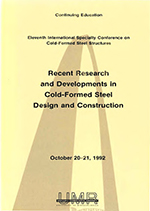Location
Saint Louis, Missouri
Session Dates
20 Oct 1992
Abstract
Cellular roof and floor decks may be formed by attaching essentially flat sheets to a "hat-shapes" or to fluted profiles by spot welding along the contact lines. This leads to a closed cellular deck unit suitable for such purposes as in-floor power distribution or communication systems. In positive bending, or when the flat sheet is in tension and stable, cellular deck flexural properties can be determined following the American Iron and Steel Institute Cold Formed Steel Design Manual. When the flat sheet is in compression, its contribution is not described in the AISI Manual since it is not continuously connected to the cell top. In earlier AISI Manual Commentaries, an approximate method was suggested for evaluating flat sheets in compression. Basically, the sheet was treated as a "column" between welds and, if this "column" did not buckle at limiting panel flexural stresses, the element edge could be treated as if it were continuously supported. Existing effective width formulas could then be used. For the vast majority of cellular deck applications, welds are not so closely spaced and column-like buckling can occur. The purpose of this study has been to address cases with larger weld spacings and to propose a general method for finding the effective width of sheets in compression when used in cellular decks.
Department(s)
Civil, Architectural and Environmental Engineering
Research Center/Lab(s)
Wei-Wen Yu Center for Cold-Formed Steel Structures
Meeting Name
11th International Specialty Conference on Cold-Formed Steel Structures
Publisher
University of Missouri--Rolla
Document Version
Final Version
Rights
© 1992 University of Missouri--Rolla, All rights reserved.
Document Type
Article - Conference proceedings
File Type
text
Language
English
Recommended Citation
Balaji, K. and Luttrell, Larry D., "Properties for Cellular Decks in Negative Bending" (1992). CCFSS Proceedings of International Specialty Conference on Cold-Formed Steel Structures (1971 - 2018). 4.
https://scholarsmine.mst.edu/isccss/11iccfss/11iccfss-session4/4
Properties for Cellular Decks in Negative Bending
Saint Louis, Missouri
Cellular roof and floor decks may be formed by attaching essentially flat sheets to a "hat-shapes" or to fluted profiles by spot welding along the contact lines. This leads to a closed cellular deck unit suitable for such purposes as in-floor power distribution or communication systems. In positive bending, or when the flat sheet is in tension and stable, cellular deck flexural properties can be determined following the American Iron and Steel Institute Cold Formed Steel Design Manual. When the flat sheet is in compression, its contribution is not described in the AISI Manual since it is not continuously connected to the cell top. In earlier AISI Manual Commentaries, an approximate method was suggested for evaluating flat sheets in compression. Basically, the sheet was treated as a "column" between welds and, if this "column" did not buckle at limiting panel flexural stresses, the element edge could be treated as if it were continuously supported. Existing effective width formulas could then be used. For the vast majority of cellular deck applications, welds are not so closely spaced and column-like buckling can occur. The purpose of this study has been to address cases with larger weld spacings and to propose a general method for finding the effective width of sheets in compression when used in cellular decks.



